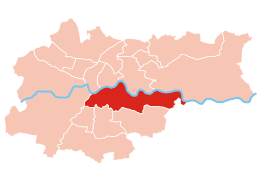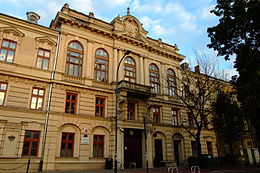Podgórze
| Podgórze district of Kraków | |
|---|---|

Popular Józefińska Street
|
|

Podgórze district on the map of Kraków after the 1990 subdivisions: see № XIII
|
|
| New districts split off in 1990 | |
|
|
 |
|
| Podgórze city hall at Rynek Podgórski 1 | |
Podgórze is a district of Kraków, Poland, situated on the right (southern) bank of the Vistula River, at the foot of Lasota Hill. The district was subdivided in 1990 into six new districts, see present-day districts of Kraków for more details. The name Podgórze roughly translates as the base of a hill. Initially a small settlement, in the years following the First Partition of Poland the town's development was promoted by the Austria-Hungary Emperor Joseph II who in 1784 granted it the city status, as the Royal Free City of Podgórze. In the following years it was a self-governing administrative unit. After the Third Partition of Poland in 1795 and the takeover of the entire city by the Empire, Podgórze lost it political role of an independent suburb across the river from the Old Town.
The administrative reform of 1810 which followed the expansion of the Duchy of Warsaw brought Podgórze together with the rest of the historic city. However, after the Congress of Vienna made Kraków a free city in 1815, Podgórze fell back under the Austrian rule and remained there for the rest of the 19th century. According to Encyclopædia Britannica, in 1910 it was the 13th largest town in the Austrian-ruled Galicia (population 18,142 in 1900). In the years leading to the return of Polish independence, the city council discussions from July 1915 made Podgórze again a part of the Greater Kraków (Wielki Kraków); its president, the vice president of a single administrative unit.
The oldest man-made structure in Podgórze is the Krakus Mound (Polish: Kopiec Krakusa) on Lasota Hill, believed to be the grave of the legendary prince Krakus. It is the largest prehistoric mound in Poland and one of the best view points in the city.
...
Wikipedia
